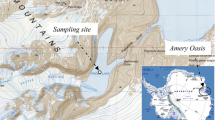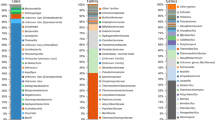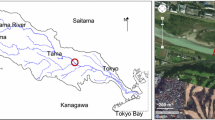Abstract
A culture-independent molecular phylogenetic approach was used to study prokaryotic diversity in an anoxic activated sludge from a municipal wastewater treatment plant. Two 16S rRNA gene libraries were constructed using total genomic DNA and amplified by polymerase chain reaction using primers specific for archaeal or bacterial domains. Phylogenetic analysis of 132 and 249 almost full-length 16S rRNA genes for Archaea and Bacteria, respectively, was done using the ARB software package. Phylogenetic groups affiliated with the Archaea belong to Euryarchaeota (93.8% of the operational taxonomic units [OTUs]) and Crenarchaeota (6.2% of the OTUs). Within the bacterial library, 84.8% of the OTUs represent novel putative phylotypes never described before and affiliated with ten divisions. The Proteobacteria phylum is the most abundant and diversified phylogenetic group representing 60.4% of the OTUs, followed by Bacteroidetes (22.1%) and gram-positives (6.1%). Interestingly, we detected a novel Proteobacteria monophyletic group distinct from the five known subclasses, which we named New Lineage of Proteobacteria (NLP) lineage, and it is composed of eight clones representing 4.6% of the Proteobacteria. A new 16S rRNA-targeted hybridization probe was designed and fluorescent in situ hybridization analyses shows representatives of NLP as cocci-shaped microorganisms. The Chloroflexi, Acidobacterium, and Nitrospira phyla and TM7 candidate division are each represented by ≤3% of clone sequences. A comprehensive set of eight 16S and 23S rRNA-targeted oligonucleotide probes was used to quantify these major groups by dot blot hybridization within 12 samples. The Proteobacteria accounted for 82.5 ± 4.9%, representing the most abundant phyla. The Bacteroidetes and Planctomycetales groups accounted for 4.9 ± 1.3% and 4 ± 1.7%, respectively. Firmicutes and Actinobacteria together accounted for only 1.9 ± 0.5%. The set of probes covers 93.4 ± 14% of the total bacterial population rRNA within the anoxic basin.


Similar content being viewed by others
References
Alm EW, Oerther DB, Larsen N, Stahl DA, Raskin L (1996) The oligonucleotide probe database. Appl Environ Microbiol 62:3557–3559
Altschul SF, Gish W, Miller W, Myers EW, Lipman DJ (1990) Basic local alignment search tool. J Mol Biol 215:403–410
Amann RI, Binder BJ, Olson RJ, Chisholm SW, Devereux R, Stahl DA (1990) Combination of 16S rRNA-targeted oligonucleotide probes with flow cytometry for analyzing mixed microbial populations. Appl Environ Microbiol 56:1919–1925
Amann RI, Ludwig W, Schleifer KH (1995) Phylogenetic identification and in situ detection of individual microbial cells without cultivation. Microbiol Rev 59:143–169
Auling G, Pilz F, Busse HJ, Karrasch S, Streichan M, Schön G (1991) Analysis of the polyphosphate-accumulating microflora in phosphoruseliminating, anaerobic-aerobic activated sludge systems by using diaminopropane as a biomarker for rapid estimation of Acinetobacter spp. Appl Environ Microbiol 57:3585–3592
Bond PL, Hugenholtz P, Keller J, Blackall LL (1995) Bacterial community structures of phosphate-removing and nonphosphate-removing activated sludges from sequencing batch reactors. Appl Environ Microbiol 61:1910–1916
Brigmon RL, Bitton G, Zam SG, O’Brien B (1995) Development and application of a monoclonal antibody against Thiothrix spp. Appl Environ Microbiol 61:13–20
Brosius J, Palmer ML, Kennedy PJ, Noller HF (1978) Complete nucleotide sequence of a 16S ribosomal RNA gene from Escherichia coli. Proc Natl Acad Sci U S A 75:4801–4805
Brosius J, Dull TJ, Sleeter DD, Noller HF (1981) Gene organization and primary structure of a ribosomal RNA operon from Escherichia coli. J Mol Biol 148:107–127
Chouari R, Le Paslier D, Daegelen P, Ginestet P, Weissenbach J, Sghir A (2003) Molecular evidence for novel planctomycete diversity in a municipal wastewater treatment plant. Appl Environ Microbiol 69:7354–7363
Chouari R, Le Paslier D, Dauga C, Daegelen P, Weissenbach J, Sghir A (2005) Novel major bacterial candidate division within a municipal anaerobic sludge digester. Appl Environ Microbiol 71(4):2145–2153
Christensson M, Blackall LL, Welander T (1998) Metabolic transformations and characterisation of the sludge community in an enhanced biological phosphorus removal system. Appl Microbiol Biotechnol 49:226–234
Cloete TE, Steyn PL (1988) A combined membrane filter-immunofluorescent technique for the in situ identification and enumeration of Acinetobacter in activated sludge. Water Res 22:961–969
Dabert P, Sialve B, Delgenes JP, Moletta R, Godon JJ (2001) Characterisation of the microbial 16S rDNA diversity of an aerobic phosphorus-removal ecosystem and monitoring of its transition to nitrate respiration. Appl Microbiol Biotechnol 55:500–509
Daims H, Purkhold U, Bjerrum L, Arnold E, Wilderer PA, Wagner M (2001) Nitrification in sequencing biofilm batch reactors: lessons from molecular approaches. Water Sci Technol 43:9–18
DeLong EF (1992) Archaea in coastal marine environments. Proc Natl Acad Sci U S A 89:5685–5689
Reyes FL De los, Ritter W, Raskin L (1997) Group-specific small-subunit rRNA hybridization probes to characterize filamentous foaming in activated sludge systems. Appl Environ Microbiol 63:1107–1117
Reyes MF De los, Reyes FL De los 3rd, Hernandez M, Raskin L (1998) Quantification of Gordona amarae strains in foaming activated sludge and anaerobic digester systems with oligonucleotide hybridization probes. Appl Environ Microbiol 64:2503–2512
Doré J, Sghir A, Hannequart-Gramet G, Corthier G, Pochart P (1998) Design and evaluation of a 16S rRNA-targeted oligonucleotide probe for specific detection and quantitation of human faecal Bacteroides populations. Syst Appl Microbiol 1:65–71
Farrelly V, Rainey FA, Stackebrandt E (1995) Effect of genome size and rrn gene copy number on PCR amplification of 16S rRNA genes from a mixture of bacterial species. Appl Environ Microbiol 61:2798–2801
Godon JJ, Zumstein E, Dabert P, Habouzit F, Moletta R (1997) Molecular microbial diversity of an anaerobic digestor as determined by small-subunit rDNA sequence analysis. Appl Environ Microbiol 63:2802–2813
Goebel BM, Stackebrandt E (1994) Cultural and phylogenetic analysis of mixed microbial populations found in natural and commercial bioleaching environments. Appl Environ Microbiol 60:1614–1621
Good IJ (1953) The population frequencies of species and the estimation of population parameters. Biometrika 40:237–264
Gray ND, Miskin IP, Kornilova O, Curtis TP, Head IM (2002) Occurrence and activity of Archaea in aerated activated sludge wastewater treatment plants. Environ Microbiol 4(3):158–168
Hernandez M, Jenkins D, Beaman BL (1994) Mass and viability estimations of Nocardia in activated sludge and anaerobic digesters using conventional stains and immunofluorescent methods. Water Sci Technol 29:249–259
Hiraishi A (1988) Respiratory quinone profiles as tools for identifying different bacterial populations in activated sludge. J Gen Appl Microbiol 34:39–56
Howgrave-Graham AR, Steyn PL (1988) Application of the fluorescent-antibody technique for the detection of Sphaerotilus natans in activated sludge. Appl Environ Microbiol 54:799–802
Hugenholtz P, Goebel BM (2001) The polymerase chain reaction as a tool to investigate microbial diversity in environmental samples. In: Rochelle PA (ed) Environmental molecular microbiology: protocols and applications. Horizon Scientific, New York, pp 31–42
Juretschko S, Loy A, Lehner A, Wagner M (2002) The microbial community composition of a nitrifying-denitrifying activated sludge from an industrial sewage treatment plant analyzed by the full-cycle rRNA approach. Syst Appl Microbiol 25:84–99
Liu WT, Nielsen AT, Wu JH, Tsai CS, Matsuo Y, Molin S (2001) In situ identification of polyphosphate- and polyhydroxyalkanoate-accumulating traits for microbial populations in a biological phosphorus removal process. Environ Microbiol 3:110–122
Macalady JL, Jones DS, Lyon EH (2007) Extremely acidic; pendulous cave wall biofilms from the Frasassi cave system, Italy. Environ Microbiol 9:1402–1414
MacGregor BJ, Toze S, Alm EW, Sharp R, Ziemer CJ, Stahl DF, Li A (2001) Distribution and abundance of gram-positive bacteria in the environment: development of a group-specific probe. J Microbiol Methods 44:193–203
Manz W, Amann R, Ludwig W, Wagner M, Schleifer KH (1992) Phylogenetic oligodeoxynucleotide probes for the major subclasses of proteobacteria; problems and solutions. Syst Appl Microbiol 15:593–600
Manz W, Amann R, Ludwig W, Vancanneyt M, Schleifer KH (1996) Application of a suite of 16S rRNA-specific oligonucleotide probes designed to investigate bacteria of the phylum Cytophaga–Flavobacter–Bacteroides in the natural environment. Microbiology 142:1097–1106
Marchesi JR, Sato T, Weightman AJ, Martin TA, Fry JC, Hiom SJ et al (1998) Design and evaluation of useful bacterium-specific PCR primers that amplify genes coding for bacterial 16S rRNA. Appl Environ Microbiol 64:795–799
Neef A, Amann R, Schlesner H, Schleifer KH (1998) Monitoring a widespread bacterial group: in situ detection of planctomycetes with 16S rRNA-targeted probes. Microbiology 144:3257–3266
Palmer CJ, Tsai YL, Paszko-Kolva C, Mayer C, Sangermano LR (1993) Detection of Legionella species in sewage and ocean water by polymerase chain reaction, direct fluorescent-antibody, and plate culture methods. Appl Environ Microbiol 59:3618–3624
Rappé MS, Kemp PF, Giovannoni SJ (1997) Phylogenetic diversity of marine coastal picoplankton 16S rRNA genes cloned from the continental shelf off Cape Hatteras, North Carolina. Limnol Oceanogr 42:811–826
Raskin L, Stromley JM, Rittmann BE, Stahl DA (1994) Group-specific 16S rRNA hybridization probes to describe natural communities of methanogens. Appl Environ Microbiol 60:1232–1240
Reysenbach AL, Giver LJ, Wickham GS, Pace NR (1992) Differential amplification of rRNA genes by polymerase chain reaction. Appl Environ Microbiol 58:3417–3418
Sghir A, Gramet G, Suau A, Rochet V, Pochart P, Doré J (2000) Quantification of bacterial groups within human fecal flora by oligonucleotide probe hybridization. Appl Environ Microbiol 66:2263–2266
Snaidr J, Amann R, Huber I, Ludwig W, Schleifer KH (1997) Phylogenetic analysis and in situ identification of bacteria in activated sludge. Appl Environ Microbiol 63:2884–2896
Stahl DA, Flesher B, Mansfield HR, Montgomery L (1988) Use of phylogenetically based hybridization probes for studies of ruminal microbial ecology. Appl Environ Microbiol 54:1079–1084
Sunagawa S, DeSantis TZ, Piceno YM, Brodie EL, DeSalvo MK, Voolstra CR, Weil E, Andersen GL, Medina M (2009) Bacterial diversity and White Plague Disease-associated community changes in the Caribbean coral Montastraea faveolata. ISME J 3:512–521
Suzuki MT, Giovannoni SJ (1996) Bias caused by template annealing in the amplification of mixtures of 16S rRNA genes by PCR. Appl Environ Microbiol 62:625–630
Völsch A, Nader WF, Geiss HK, Nebe G, Birr C (1990) Detection and analysis of two serotypes of ammonia-oxidizing bacteria in sewage plants by flow-cytometry. Appl Environ Microbiol 56:2430–2435
Zheng D, Alm EW, Stahl DA, Raskin L (1996) Characterization of universal small subunit rRNA hybridization probes for quantitative molecular microbial ecology studies. Appl Environ Microbiol 62:4504–4513
Acknowledgments
This study was partly supported by a grant from the European Union for research project WIRES (EVK1-CT2000-00050). We are very grateful to S. Cure for reading the manuscript, to the Genoscope sequencing team for the technical assistance, and M. Trouvé and D. Dehon for providing the samples from the WWTP.
Author information
Authors and Affiliations
Corresponding author
Rights and permissions
About this article
Cite this article
Chouari, R., Le Paslier, D., Daegelen, P. et al. Molecular Analyses of the Microbial Community Composition of an Anoxic Basin of a Municipal Wastewater Treatment Plant Reveal a Novel Lineage of Proteobacteria . Microb Ecol 60, 272–281 (2010). https://doi.org/10.1007/s00248-009-9632-7
Received:
Accepted:
Published:
Issue Date:
DOI: https://doi.org/10.1007/s00248-009-9632-7




